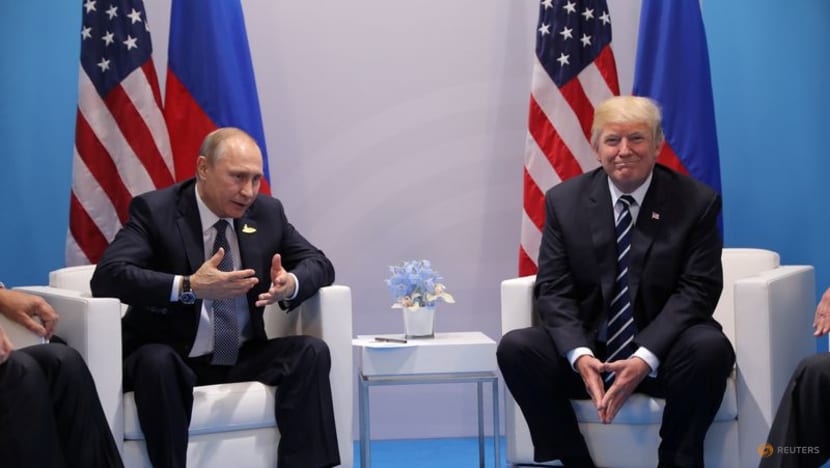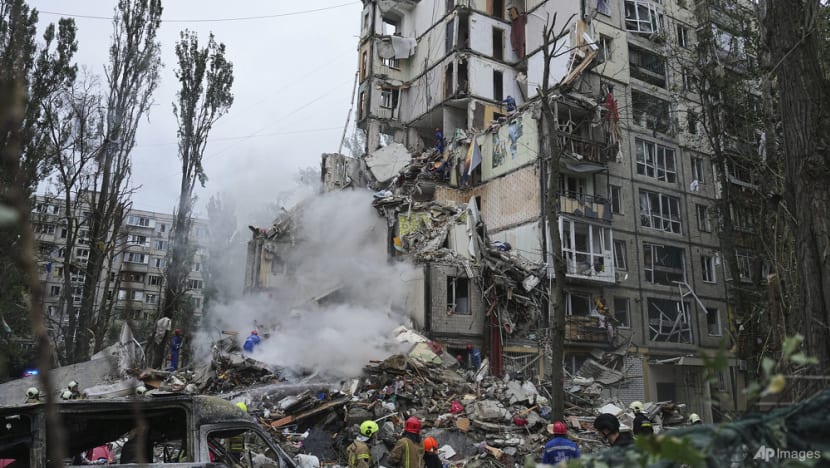Commentary: Trump's ultimatum on Ukraine is put to the test by Putin
If US President Donald Trump follows through on threats to impose “secondary tariffs” on Russia, it would increase the chances of a ceasefire and Ukraine’s survival, says international security professor Stefan Wolff.

Russia's President Vladimir Putin talks to US President Donald Trump during their bilateral meeting at the G20 summit in Hamburg, Germany on Jul 7, 2017. (File photo: REUTERS/Carlos Barria)

This audio is generated by an AI tool.
BIRMINGHAM, United Kingdom: Against a backdrop of threats Donald Trump made but never followed through and demands ignored by Vladimir Putin without consequences, the United States president issued the latest ultimatum to his Russian counterpart: Make progress toward a ceasefire within 50 days or prepare for tariffs.
It was already a major shift in Mr Trump’s approach to the war in Ukraine, before he dramatically cut his deadline. His ultimatum will now expire on Friday (Aug 8), instead of Sep 2.
This is not the first time that Mr Trump has tried his economic brand of diplomacy on Mr Putin, though he constantly oscillated between pressure on Ukraine and on Russia. On Jan 22, just two days after his return to the White House for a second term, he demanded on Truth Social that Russia “STOP this ridiculous war” or face trade sanctions.
By May, Mr Trump suspected he was being strung along and gave Mr Putin two weeks to respond to his calls for a ceasefire. Vague as this appeared at the time, it was the first time that Mr Trump imposed a concrete timeline.
The Russian president did not blink. On the contrary, Russia intensified both its air and ground campaigns against Ukraine.
The Russian reaction to the original 50-day ultimatum indicated no particular concern in the Kremlin. Widespread criticism that this simply gave Russia another seven weeks to pound Ukraine was swiftly borne out, including the capture of Chasiv Yar, a town in eastern Ukraine that Russia had besieged for more than a year.
On Aug 1, Mr Putin signalled that there would be no change to his stance, as Mr Trump’s shortened deadline loomed.
WILL “SECONDARY TARIFFS” UP THE PRESSURE?
If it were only the threat of sanctions by Washington, Moscow might be right to shrug off the ultimatum as another unenforceable threat and unlikely to have a major impact on Russia’s remarkably resilient war economy.
But the stakes are now more complex and go beyond another customary Russian warning of impending nuclear armageddon. This is despite Mr Trump ordering two nuclear submarines to be ”positioned in the appropriate regions” following a very public social media fight with former Russian president Dmitry Medvedev, now the deputy chairman of Russia’s national security council.
Mr Trump has threatened to impose what he called 100 per cent “secondary tariffs” – which is not a technical term but has come to mean tariffs on US imports from countries which trade with Russia.
India and China are the two largest remaining buyers of Russian oil. India’s Aug 1 tariff rate has been announced at 25 per cent, with an unspecified “penalty” for its trade ties with Russia and would affect billions of dollars of exports to the United States.
New Delhi and Beijing may not immediately stop trading with Moscow, but they may exert pressure on Mr Putin to at least show progress on a ceasefire. Russia’s dependence on China, in particular, and in turn China’s high trade volumes with the US are a key vulnerability for Mr Putin that Mr Trump finally appears willing to exploit.
MORE MILITARY SUPPORT
Moreover, Mr Putin’s obstinance has now provoked Mr Trump’s ire, making him look the weaker party who can be repeatedly ignored. The threat of sanctions is now only one of the Russian president’s worries.
More significantly, beyond ultimatums issued and ignored, Mr Trump has also re-committed the United States to militarily supporting the Ukrainian war effort.

Making more “top of the line” weapons available to European NATO allies will deliver much needed air defences and offensive weapons to Kyiv. More European investment in its own defence-industrial base and in cooperation and joint ventures with Ukrainian partners will further strengthen Kyiv’s military capabilities.
None of this will be a game-changer overnight but it will prevent Ukrainian defences and morale from being further eroded by Russia’s slow-grinding advances.
“PRESIDENT OF CEASEFIRES”
After months of mixed signals, it now appears that Mr Trump may have decisively pivoted towards Ukraine. This is possibly due to a mix of frustration with Mr Putin and much improved relations with Ukrainian President Volodymyr Zelenskyy, from whom Mr Trump secured a deal on critical minerals.
Given the American president’s notorious unpredictability, how long this will last is everybody’s guess.
If Mr Trump finally follows through on his threats to impose steep costs on Russia, at the very least, he will have massively increased Ukraine’s long-term chances of survival as a sovereign country.
Count on Mr Putin to continue his defiance: He still thinks he can win the war and – with high if almost certainly over-stated approval ratings – faces little domestic pressure to stop.
But a ceasefire is now more likely before the end of the year, albeit not before Washington’s latest ultimatum expires.
Mr Trump, who has tried to fashion himself as a “president of peace”, is still a long way off earning this title. But, with some peacemaking successes elsewhere already in the bag, he may be a step closer to becoming the “president of ceasefires”.
Stefan Wolff is Professor of International Security at the University of Birmingham and Head of the Department of Political Science and International Studies.


















